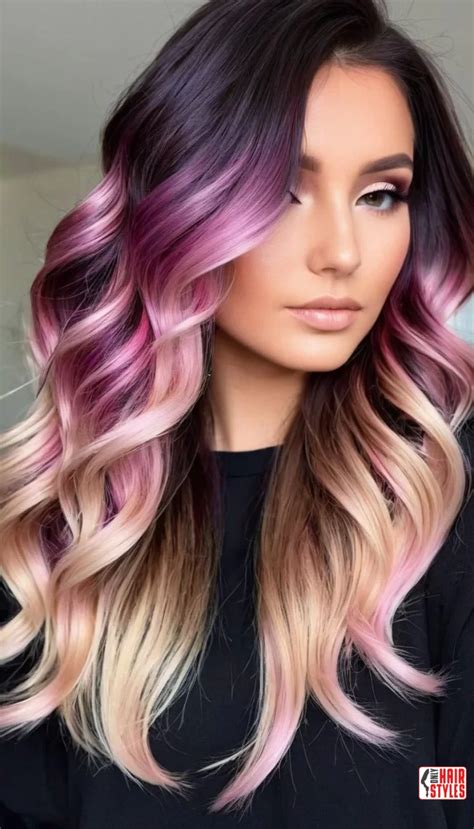The Psychology of Hair Color
Hair color profoundly influences our perception of individuals and evokes distinct emotions and associations. Studies by the American Psychological Association have shown that:

- Brunettes are often perceived as sophisticated, intelligent, and trustworthy.
- Blondes exude a sense of femininity, youthfulness, and approachability.
- Redheads are associated with passion, confidence, and creativity.
The psychological impact of hair color highlights its role in shaping our personal and social interactions.
Factors to Consider When Choosing a Hair Color
Selecting the most flattering hair color for your unique features involves considering several key factors:
- Skin Tone: Warm skin tones complement golden and copper hues, while cool skin tones harmonize with ash and blue-based shades.
- Eye Color: Blue and green eyes are enhanced by blonde, brown, or red tones. Hazel and brown eyes can withstand bolder colors like burgundy or violet.
- Age: As we age, our hair naturally loses pigment. Warm and lighter colors can restore youthfulness, while darker shades can enhance maturity.
- Personal Style: Your hair color should reflect your individual aesthetic and lifestyle. Consider both classic and trendy hues.
Best Hair Color for Different Skin Tones
Fair Skin Tones:
- Blonde: Platinum, honey, or strawberry blonde
- Brown: Caramel, golden brown, or light chestnut
- Red: Copper, auburn, or mahogany
Warm Skin Tones:
- Blonde: Golden blonde, amber, or warm honey
- Brown: Chocolate brown, toffee, or cinnamon
- Red: Burgundy, ginger, or auburn
Cool Skin Tones:
- Blonde: Ash blonde, platinum, or icy white
- Brown: Ash brown, chocolate brown, or blue-black
- Red: Reddish-brown, strawberry red, or plum
Best Hair Color for Different Eye Colors
Blue Eyes:
- Blonde: Platinum, honey blonde, or ash blonde
- Brown: Caramel, chestnut, or chocolate brown
- Red: Auburn, copper, or mahogany
Green Eyes:
- Blonde: Warm honey, golden blonde, or caramel
- Brown: Chocolate brown, auburn, or light chestnut
- Red: Burgundy, copper, or redhead
Hazel Eyes:
- Blonde: Golden blonde, caramel, or honey blonde
- Brown: Light brown, chocolate brown, or chestnut
- Red: Auburn, burgundy, or reddish-brown
Brown Eyes:
- Blonde: Honey blonde, golden blonde, or warm brown
- Brown: Chocolate brown, medium brown, or black
- Red: Burgundy, mahogany, or copper
Age-Appropriate Hair Color
As we mature, our hair color naturally changes. Here are guidelines for age-appropriate hair hues:
20s: Bold and vibrant colors that reflect youthfulness, such as bright blonde or fiery red.
30s: Sophisticated and flattering shades that enhance maturity, such as caramel brown or ash blonde.
40s: Warmer and brighter colors that restore radiance, such as golden brown or strawberry blonde.
50s and Beyond: Classy and elegant hues that enhance gray hairs, such as silver, platinum, or beige.
Trending Hair Color Techniques
Hair color technology is continuously evolving, offering innovative techniques to achieve stunning results:
- Balayage: A freehand painting technique that creates soft, blended highlights.
- Ombré: A gradual transition from one hair color to another, with darker roots blending into lighter ends.
- Foilayage: A combination of balayage and foiling for precise and dimensional highlights.
- Root Shadowing: A technique that creates a subtle shadow at the roots, blending with the rest of the hair color.
Choosing a Hair Colorist
A professional hair colorist is essential for achieving the best results. When selecting a hair colorist, consider:
- Experience: The number of years and range of clients they have worked with.
- Portfolio: Review their portfolio to assess their skills and aesthetic.
- Consultation: Schedule a consultation to discuss your desired color and receive professional recommendations.
Benefits of Choosing the Right Hair Color
The right hair color can:
- Enhance your features: Hair color can accentuate your eyes, skin tone, and bone structure.
- Boost your confidence: A flattering hair color can make you feel more beautiful and self-assured.
- Complete your style: Hair color is an integral part of your overall look, complementing your clothing and accessories.
- Refresh your appearance: A change in hair color can instantly update your look and give you a fresh start.
Conclusion
Choosing the best hair color is a personal and transformative decision. By considering your skin tone, eye color, age, and personal style, you can select a hair color that flatters your unique features and enhances your natural beauty. Remember to consult with a professional hair colorist to achieve optimal results and reap the benefits of a well-chosen hair color.
